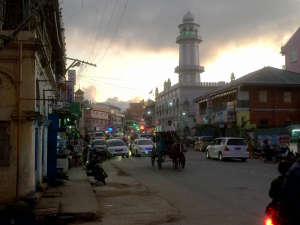12 November 15 – Thursday – DAY SIX
I wake with a deep cough. I feel okay, basically, a bit run down. The cough is a bad omen, though. These days if I get any upper respiratory infection it goes to a bronchitis pretty easily. It’s the result of being a poor young man who did not take care of himself and endured Chicago winters without going to the doctor and without proper shoes. In essence, I deserve it for being stupid while broke. I seem to have scarred up my lungs so bad that pretty much any small bug will get in there and cause havoc. I’ve had a walking pneumonia twice in the last five years, and it feels like this right now.
I ask Gavin today about the likelihood of getting a penicillin or even a Z-pak (Azithromycin). I don’t think I need it yet, but I’m looking forward and thinking of the future. I could just try to be good about food and sleep, but it’s not so easy. This morning Cecilia forgot to set the alarm and we woke in a panic. We’re already late for the van, and I do not get any breakfast. So I grab what I can to fuel up and rush out the door.
We’re indoors today, and that helps a lot. It was rain all day at the school – big bursts of typical Asian rain punctuated by a flurry of people running with umbrellas. Without the weather beating down on me maybe I can relax a bit and catch a short nap here and there. The problem with my immune system is that whereas my lungs are apparently a bit on the worn out side, the rest of me shoulders on like an ox. I have walking pneumonia because I’m rarely down with anything; I tend to work right past most ailments.
That shoulder pain I’ve had for the last six months (probably arthritis) is a good example. Most times I lift the boom I can feel that thing grinding away in there, but I just keep on working through it. As a result the shoulder feels better than it has in a long time, even though all I’m doing is working it.
We get to the sewing shop just in time for me to finish wolfing down portable fruit and snacks I hastily grabbed for my breakfast. I drain the last dregs of my morning cola and get ready to wire up Tinmar Aung.
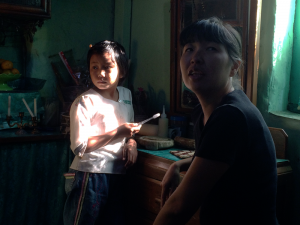
“Every Shot a Masterpiece.” That’s what we all say when we see a great film by a director we admire. Well, we on the crew say this; maybe you don’t. It’s a different matter trying to get that masterpiece, though. Sometimes I worry Gavin is making a pastiche – he will say “I want something just like that Apitchatpong shot.” But when I see the shot, I agree – it’s “like” that Apitchatpong shot, but it’s not that shot. So I’m relieved. But “Every Shot a Masterpiece” does take time, and I wonder sometimes if we’re noodling it and neglecting some bigger concerns.
Half an hour later, when the first shot is taken, it’s exquisite – Gavin’s got people and camera orchestrated in such a way that, indeed, the shot is brilliant. We are not always lucky, but we’re riding high when we see dailies each night.
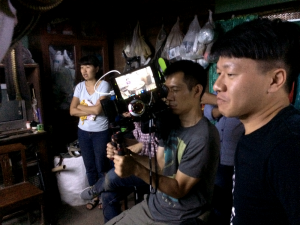
But the tweak heads (namely Gavin and Sean in a savage double act that literally eats time as it spools off the Hourglass of Doom) have really got us hung up when, 11 takes later, we’ve only just wrapped a single scene that we prepped for one hour. Not only that, but we went seriously into our lunch time again, and it’s late in the afternoon already. Starving, we tuck into another fabulous spread by Hone Hone.
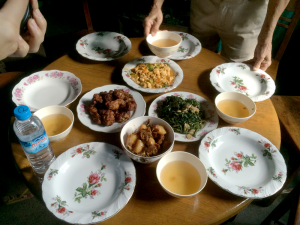
Gavin is now practicing with Tinmar Aung and Daw Marai, who plays our Grandma. The girl out-acts the older woman so shamelessly. Daw Marai is uncomfortable speaking any lines at all, even when Gavin suggests she switch to her native dialect (she’s Kachin). She’s generally not as good, and this frustrates Tinmar quite a bit, and she loses focus. It’s just plain boring for her.
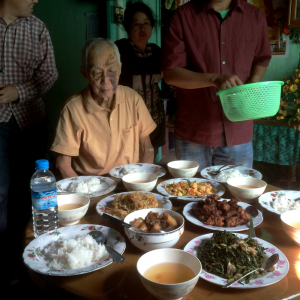
While Gavin runs lines with John translating for the actors, Sean and Minshi worry. The Shogun overheats, and we’ve been working it really hard, especially for yesterday’s 40 minute takes. A couple times it has either glitched out or split the file into segments. After only six days that seems like trouble for the production. Our “Burmese Vacation” is not yet one third over, and with a major equipment malfunction our camera crew is now wondering if we’re going to finish.
Of course it’s doom and gloom – there’s nothing to suggest the Shogun won’t perk up in the end, and Sean seems to have some idea why it’s doing what it’s doing. There’s some correlation with ISO it seems, but even more correlation with using the external battery to drive both camera and recorder. The problem manifests as very faint horizontal lines in the picture – a kind of digital noise we think may be generated by current somehow. The battery is the leading theory anyway.
After a punishing couple of hours rehearsing, Gavin is ready to set up the shot with Grandma. Daw Marai is a lovely person, but this is certainly the end of her acting career, which, coincidentally, has also just begun with this production. We do take after take, and the number is going well into double digits. The crew are antsy, and my arms are aching. Gavin just goes right to the next take without any break in between, and soon my arms are tingling with nerve damage from the ordeal.
Even so, these are important scenes. Tinmar Aung has a tough time getting through them. The film is about familial love, and this scene is about the Grandmother making sacrifices for her. When she has to think about that, her crappy life comes to mind, and tears come to her eyes. She blows a few takes just racing through the lines so she can get it all out with breaking down. We’re all worried about putting her through too much or exploiting her.
Finally we have enough in the can, and we break down for the day. Gavin, our cruel dictator, finally ends after 15 takes of the scene, all punishingly performed in a single shot. Everyone is physically and mentally exhausted.
Later that night, after dailies, we end up discussing story problems. Gavin is still hiding the fact that he has some major story holes he has not filled in. Though he left LA with a treatment that was more than sound, he seems to have altered it the moment his feet touched ground in Myanmar. That’s obviously the correct thing to do; he wrote his movie not really knowing what the reality of the situation was. He had only a brief visit years earlier, and now he had very specific things to arrange for a very concrete process.
Stories are a bit delicate, though. Remove a chunk and things feel faster. Gavin already had a problem maintaining a sense of time since he had only an “A” story – without any other set of characters to cut to, he could only construct a temporally contiguous world through the eyes of Tinmar Aung, and had no other character or situation to fall back on. He could not leave her one night in bed, cut to another set of people, and then go back to her at the end of that second day. He could only cut from situations with her to situations with her.
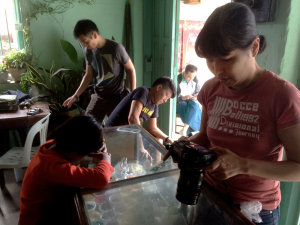
All of which meant that the major chunk he took out would need to be filled. Even worse, the chunk he cut out was from the second act of the film. Though Gavin’s film was not rigorously structured according to the dictates of a screenplay guru, I had definitely helped guide the story along very simple but classical lines. In order to keep people in their seats for at least 90 minutes, you have to employ some devices to keep them interested. Thus the idea of using a very loose structure to keep the story together and to keep it from seeming rambly and disconnected. Both of which things are perfectly fine for shorter work, but when an audience invests as much as 90 minutes on something, they generally prefer that it leads somewhere and does not just noodle about.
The second act of any screenplay is a notorious tar pit for most writers. It’s where lots of people make the biggest mistakes, and it’s where most screenplays really lose focus and energy. It’s not particularly difficult, but everyone seems to forget what the second act is about, or they get tired or give up. I’m not quit sure what it is – I’m actually pretty good with a second act. But here Gavin had eviscerated the biggest trouble spot most writers fear. He went right for the heart of the beast. That could have been because, like most writers, his second act was rambly and diffuse, leading him to believe that it was unnecessary. I’ll defend his decision to excise material that was flabby and did not serve his ultimate aims.
But leaving a hole in it was probably not the best idea, and by the eighth day of shooting it was abundantly clear that the film would only have about an hour’s worth of story. Gavin kept talking about “filler” and “going back” to scenes we’d already done before. It was clear he was floundering on this point. Again, this is also nothing new. His panic over trying to “fill” time with unnecessary scenes was at least motivated by his internal sense that the material was not long enough. But he was not thinking dramatically.
My screenwriting teacher, the late, and most assuredly great Frank Daniel, had the best attitude towards structure I had ever heard, which is why I followed him so ardently. For Frank structure was only necessary when you lost your way. It was a road map you conveniently pulled out when you felt like you could not get back to the correct path. If you did not need it, you could keep it safely hidden, but you had to know where you were going.
Frank’s course of study took him through classical dramatic sources all the way to 19th century theatrical guides and what was called “the well-made play.” High school drama enthusiasts may have been introduced to those kinds of ideas, which included the notion of “the unities,” Unity of Action, Unity of Time, and Unity of Space. These were, of course, developed by Aristotle, and sanctioned by 19th century dramatists. Frank felt that film was more encompassing than the unities would allow – we could certainly make films that spanned eons should we like, and through the magic of editing connect spaces and actions that theatre could not possibly convey.
What Frank preserved the most from classical drama was the idea that a dramatic work used specific tools and techniques to modulate the interests of the audience, such that they kept watching. It’s an old story that another Frank, namely Capra, claimed his job was “to keep butts in seats.” An audience’s level of interest needs to be addressed, caressed, and sometimes distressed, but the artist’s main task is to keep them engaged. You cannot make them interested in characters and story just to “fill time” and pad out the length of the film. They’ll know it, and they’ll hate you for it. After all, you have that attitude when you watch a film. You’ll turn it off then and there if you feel like it’s not going anywhere or is going to end up boring you.

The first act of most dramatic films, in the simplest form, has a few functions. It introduces the protagonist (the main character that you follow), tells you about the time and place of the story, and unveils a problem for the protagonist to confront. This is called the catalyst. Lately people have taken to calling it the “inciting incident,” as if all incidents were not somehow inciting. But there is a perfectly good name for it already, so don’t fall for the script witch doctors and their funky new names. “Catalyst” will do fine.
Anyway, no catalyst, no story. Something has to propel our character into a new situation that they must handle. In our film we are introduced to Tinmar Aung’s character and shown her life. When Grandma falls and injures herself, we have a movie now. This event will send Tinmar Aung on course that we must make interesting to the audience.
The third act is also simple. Yes, I know I’ve skipped over the second, so bear with me here. In the third act a possible and likely solution to the problem is enacted by the protagonist with the result of either success or failure. Not hard. So how about the second act? What’s so hard about it?
Traditionally the second act is twice the size of the first or third. It’s the long middle and it is characterized, as Frank would say, by ambiguity. As with a cat, the writer must tease the audience by suggesting, alternately, that our protagonist will and won’t solve the problem. A good description of the second act is that it is full of complications and reversals. Thus, if our protagonist is to succeed in a story, we must have a midpoint in the second act in which they fail miserably. The failure galvanizes him or her to try again, and we move towards the third act. If the protagonist is to fail, we must have a high midpoint, in which everything is going well.
Without the correct number of beats in the second act we run the risk of boring the audience. If there are no rises and falls, no opportunities for our Tinmar Aung to succeed or fail, no complications that make her life more difficult, then we will tune out.
At this point we desperately need a story conference.
